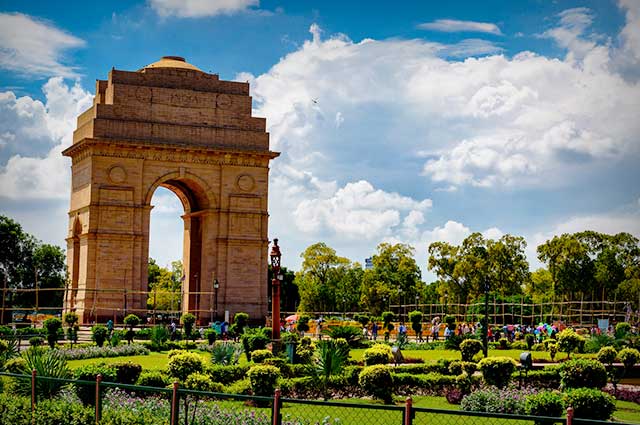The India Gate - Delhi Monuments
India Gate Delhi – The India Gate
(originally called the All India War Memorial) is a war memorial located
astride the Rajpath, on the eastern edge of the "ceremonial axis" of
New Delhi, India, formerly called Kingsway.
IndiaGate is a memorial to 70,000 soldiers of the British Indian Army who died in
the period 1914–21 in the First World War, in France, Flanders, Mesopotamia,
Persia, East Africa, Gallipoli and elsewhere in the Near and the Far East, and
the Second Anglo-Afghan War. 13,300 servicemen's names, including some soldiers
and officers from the United Kingdom, are inscribed on the gate. The India
Gate, even though a war memorial, evokes the architectural style of the
triumphal arch like the Arch of Constantine, outside the Colosseum in Rome, and
is often compared to the Arc de Triomphe in Paris, and the Gateway of India in
Mumbai. It was designed by Sir Edwin Lutyens.

In
1972, following the Bangladesh Liberation war, a small simple structure,
consisting of a black marble plinth, with a reversed rifle, capped by a war
helmet, bounded by four eternal flames, was built beneath the soaring Memorial
Archway. This structure, called Amar Jawan Jyoti, or the Flame of the Immortal
Soldier, since 1971 has served as India's Tomb of the Unknown Soldier. India
Gate is counted among the largest war memorials in India.
History of India
Gate -The India Gate is situated in Delhi,was part of the work of the Imperial War
Graves Commission (I.W.G.C), which came into existence in December 1917 for
building war graves and memorials to soldiers who were killed in the First
World War
The
foundation stone of the All-India War Memorial was laid on 10 February 1921, at
4:30 PM, by the visiting Duke of Connaught in a solemn soldierly ceremony
attended by Officers and Men of the British Indian Army, Imperial Service Troops,
the Commander in Chief, and Chelmsford, the viceroy. On the occasion, the
viceroy said, "The stirring tales of individual heroism, will live for
ever in the annals of this country", and that the memorial which was a
tribute to the memory of heroes, "known and unknown" would inspire,
future generations to endure hardships with similar fortitude and "no less
valour".
TheKing, in his message, read out by the Duke said "On this spot, in the
central vista of the Capital of India, there will stand a Memorial Archway,
designed to keep" in the thoughts of future generations "the glorious
sacrifice of the officers and men of the British Indian Army who fought and
fell". During the ceremony, the Deccan Horse, 3rd Sappers and Miners, 6th
Jat Light Infantry, 34th Sikh Pioneers, 39th Garhwal Rifles, 59th Scinde Rifles
(Frontier Force), 117th Mahrattas, and 5th Gurkha Rifles (Frontier Force), were
honoured with title of "Royal" in recognition of the distinguished
services and gallantry of the British Indian Army during the Great War".
Ten
years after the foundation stone laying ceremony, on February 12, 1931, the All
India War Memorial was inaugurated by Viceroy Lord Irwin, who on the occasion
said "those who after us shall look upon this monument may learn in
pondering its purpose something of that sacrifice and service which the names
upon its walls record."
In
the decade between the laying of foundation stone of the War memorial and its
inauguration, the rail-line was shifted to run along the Yamuna river, and the
New Delhi Railway Station was opened in 1926.
TheIndia gate, which is illuminated every evening, from 19:00 to 21:30, is a major
tourist attraction. Cars, traveled through India Gate until it was closed to
traffic. The Republic Day Parade starts from Rashtrapati Bhavan and passes
around the India Gate.

In
2017, the India Gate was twinned with the Arch of Remembrance in Leicester,
England—another Lutyens war memorial following a very similar design but on a
smaller scale. In a ceremony, India's high commissioner to the United Kingdom
laid a wreath at the arch in Leicester and the British high commissioner to
India laid one at the India Gate.
Design of India
Gate –The All-India War Memorial in New Delhi was designed by Edwin Lutyens, who was
not only the main architect of New Delhi, but a leading designer of war
memorials. He was a member of the IWGC, and one of Europe's foremost designers
of war graves and memorials. He designed sixty-six war memorials in Europe,
including the highly regarded Cenotaph, in London, in 1919, the first national
war memorial erected after World War I, for which he was commissioned by David
Lloyd George, the British prime minister. All-India War Memorial in New
Delhi, like the Cenotaph, in London, is secular memorial, free of religious and
"culturally-specific iconography such as crosses". Lutyens according
to his biographer, Christopher Hussey, relied on "elemental Mode", a
style of commemoration based on "universal architectural style free of
religious ornamentation". The India Gate, which has been called a
"creative reworking of the Arc de Triomphe" has a span of 30 feet,
and lies on the eastern axial end of Kingsway, present day Rajpath, the central
vista and main ceremonial procession route in New Delhi.
The
42-metre (138-foot)-tall India Gate, stands on a low base of red Bharatpur
stone and rises in stages to a huge moulding. The shallow domed bowl at the top
was intended to be filled with burning oil on anniversaries but this is rarely
done. The India Gate hexagon complex, with a diameter of about 625 metres,
covers approximately 306,000 m² in area. India gate bears an uncanny
resemblance to Teli Ka Mandir situated in Gwalior fort.
The
best time to visit India Gate is amid summers. Generally people prefer visiting
the place after sunset or at night so as to view the illuminated India Gate and
enjoying with the flock of locals at this time.



Comments
Post a Comment